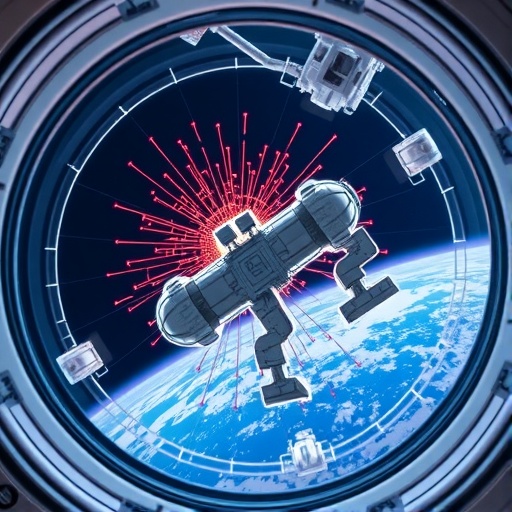Recent research conducted on the effects of simulated microgravity on testicular health in rats has unveiled critical information about the underlying biological mechanisms involved. Scientists led by Ge et al. have shed light on how the C/EBP-β/MeCP2/Wnt axis plays a role in testicular injury within this context. This research is particularly relevant given the increasing interest in the effects of microgravity on biological systems, especially as human space travel becomes more feasible and frequent.
Microgravity conditions, which can be simulated in various laboratory settings, provide a unique opportunity to study the impacts of reduced gravitational forces on biological organisms. Previous studies have shown that prolonged exposure to microgravity can lead to a range of physiological changes, affecting different organ systems. Specifically, the male reproductive system appears to be particularly vulnerable to these changes, leading researchers to investigate the molecular underpinnings of such injuries.
The study found that one of the critical pathways affected by microgravity is the C/EBP-β/MeCP2/Wnt signaling axis. This pathway is known for its crucial roles in cell growth, differentiation, and metabolic regulation. C/EBP-β is a transcription factor that influences the expression of various target genes, while MeCP2 is a protein that binds to methylated DNA and is implicated in gene regulation. The Wnt signaling pathway is instrumental in developmental processes and cellular communication. The interplay among these components appears to contribute to the vulnerability of testicular tissues under simulated microgravity.
In their experiments, the researchers exposed laboratory rats to conditions mimicking low-gravity environments. They carefully monitored the physiological responses of the testicular tissues, observing significant alterations in structure and function. The team utilized various molecular techniques to assess changes in gene expression and protein levels, providing a comprehensive picture of the testicular response to simulated microgravity.
One of the most significant findings of their study is the alteration in gene expression linked to spermatogenesis and testosterone production. The disruption of these processes may lead to potential fertility issues, raising concerns about the long-term effects of space travel on male reproductive health. This outcome underscores the importance of investigating the reproductive implications of extended space missions, especially for future astronauts who may be exposed to microgravity for extended periods.
Additionally, the team observed that the inhibition of the C/EBP-β/MeCP2 axis mitigated some of the harmful effects on testicular tissues. This discovery points toward potential avenues for therapeutic intervention that could protect against testicular injury during space travel. By exploring pharmacological agents or genetic modifications that target this signaling pathway, researchers aim to safeguard male reproductive health in astronauts.
The ramifications of these findings extend beyond the realm of space exploration. Understanding how microgravity affects testicular function can provide insights into similar conditions on Earth, such as physical inactivity and its effects on fertility. Moreover, the research highlights the adaptive mechanisms that organisms employ in response to environmental stressors, revealing intricate biological processes that warrant further investigation.
The study by Ge et al. opens new avenues for future research, emphasizing the need for interdisciplinary approaches to understand the complexities of human health in extreme environments. By bridging the fields of reproductive biology, molecular genetics, and space medicine, researchers can foster innovations that could enhance not only the understanding of reproductive health but also the development of effective countermeasures to protect astronauts during their missions.
Continued investigations into the C/EBP-β/MeCP2/Wnt axis and its role in testicular health will enrich our comprehension of male reproductive physiology in microgravity and potentially lead to the identification of biomarkers for assessing reproductive risk in aerospace environments. As the discourse surrounding space travel moves forward, so too must our awareness of its implications for human health.
In conclusion, the findings from this study contribute significantly to our understanding of how environmental factors shape reproductive health. Addressing these issues is paramount as we move toward a future where human presence in space becomes commonplace. As researchers delve deeper into the molecular mechanisms at play, we anticipate further revelations that will enhance both our approach to space exploration and our understanding of reproductive biology on Earth.
The exploration of reproductive health in microgravity serves as a reminder of the interconnectedness of various biological systems. As science continues to advance, the potential for groundbreaking discoveries in space medicine and reproductive research will pave the way for healthier outcomes for future generations of astronauts.
The implications of understanding the C/EBP-β/MeCP2/Wnt pathway could reverberate far beyond the confines of space research. The quest for knowledge in this area has the potential to illuminate aspects of reproductive health affected by environmental stresses across various fields. This research serves as a vital step in ensuring that as we reach for the stars, we do not overlook the fundamental intricacies of our biology.
Subject of Research: The effects of simulated microgravity on testicular injury in rats.
Article Title: C/EBP-β/MeCP2/Wnt Axis Participates in the Testicular Injury in Rats Under Simulated Microgravity Conditions.
Article References: Ge, P., Wang, SY., Zhang, X. et al. C/EBP-β/MeCP2/Wnt Axis Participates in the Testicular Injury in Rats Under Simulated Microgravity Conditions. Reprod. Sci. (2025). https://doi.org/10.1007/s43032-025-01965-w
Image Credits: AI Generated
DOI:
Keywords: Microgravity, Testicular Injury, C/EBP-β, MeCP2, Wnt Signaling, Fertility, Space Medicine.




